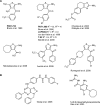International Union of Basic and Clinical Pharmacology. LXXXI. Nomenclature and classification of adenosine receptors--an update
- PMID: 21303899
- PMCID: PMC3061413
- DOI: 10.1124/pr.110.003285
International Union of Basic and Clinical Pharmacology. LXXXI. Nomenclature and classification of adenosine receptors--an update
Abstract
In the 10 years since our previous International Union of Basic and Clinical Pharmacology report on the nomenclature and classification of adenosine receptors, no developments have led to major changes in the recommendations. However, there have been so many other developments that an update is needed. The fact that the structure of one of the adenosine receptors has recently been solved has already led to new ways of in silico screening of ligands. The evidence that adenosine receptors can form homo- and heteromultimers has accumulated, but the functional significance of such complexes remains unclear. The availability of mice with genetic modification of all the adenosine receptors has led to a clarification of the functional roles of adenosine, and to excellent means to study the specificity of drugs. There are also interesting associations between disease and structural variants in one or more of the adenosine receptors. Several new selective agonists and antagonists have become available. They provide improved possibilities for receptor classification. There are also developments hinting at the usefulness of allosteric modulators. Many drugs targeting adenosine receptors are in clinical trials, but the established therapeutic use is still very limited.
Figures












References
-
- Abo-Salem OM, Hayallah AM, Bilkei-Gorzo A, Filipek B, Zimmer A, Müller CE. (2004) Antinociceptive effects of novel A2B adenosine receptor antagonists. J Pharmacol Exp Ther 308:358–366 - PubMed
-
- Al Jaroudi W, Iskandrian AE. (2009) Regadenoson: a new myocardial stress agent. J Am Coll Cardiol 54:1123–1130 - PubMed
-
- Alsene K, Deckert J, Sand P, de Wit H. (2003) Association between A2a receptor gene polymorphisms and caffeine-induced anxiety. Neuropsychopharmacology 28:1694–1702 - PubMed
-
- American Psychiatric Association (1994) Diagnostic and Statistical Manual of Mental Disorders, 4th ed American Psychiatric Association, Arlington, VA
-
- Arslan G, Kull B, Fredholm BB. (1999) Signaling via A2A adenosine receptor in four PC12 cell clones. Naunyn Schmiedebergs Arch Pharmacol 359:28–32 - PubMed
Publication types
MeSH terms
Substances
Grants and funding
LinkOut - more resources
Full Text Sources
Other Literature Sources
Molecular Biology Databases

